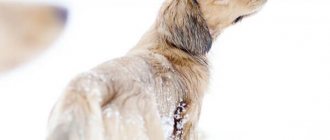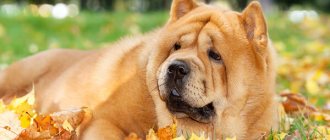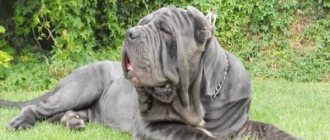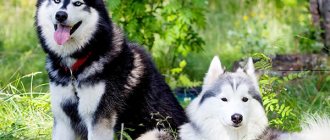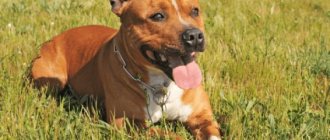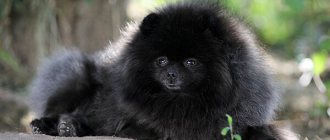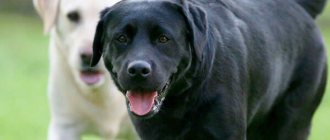A dachshund is, as most people think, a smooth-haired, squat dog with a long body and short legs.
But such dogs are by no means the only ones within the breed.
Their wire-haired counterparts are less common, but are in no way inferior in all respects. They are also active, mobile, and inquisitive.
Their distinctive feature is their unusual fur and the same appearance.
Origin story
The history of dachshunds originates in Germany.
NOTE!
These were hunting dogs that were primarily used to hunt badgers.
Courage, ingenuity, mobility - these are the distinctive features of the dachshund, and in the process of improving the breed, playfulness and friendliness were added to it. Initially, the goal of breeders was to improve hunting qualities, as well as the quality of wool (increasing its protective properties).
The result of such experiments is the emergence of three varieties of dachshunds:
- classical;
- wire-haired;
- rabbit
As for the wire-haired dachshund, its standards were officially approved in 1915 in Germany.
History and selection of the breed
The dachshund was bred in the mid-18th century. in Germany for hunting burrowing animals - badgers and foxes. At this time, the first nurseries arose, which kept decorative and hunting dachshunds. The breed standard was described only in 1870. The wire-haired species appeared a few years later as a result of crossing the Dinmont Terrier and the smooth-haired dachshund.
Appearance of a wire-haired dachshund
For your information! In the 20th century in Russia there was a dog breeders club where exhibitions were organized and records were kept about pets. At this time, the dachshund was considered a decorative breed, the representatives of which numbered only 11 individuals after the Second World War.
In European countries and Germany, the wire-haired type of dachshund is very popular among dog owners; in the Russian Federation, dog breeders more often have smooth-haired and long-haired representatives of the breed.
Character traits
If you treat your dog well, it will reciprocate - this is the nature of dachshunds . However, if you offend her, she is quite capable of standing up for herself.
Both a child and an elderly person can easily find a common language with a dachshund. As for the owner, the dachshund simply adores him.
The dog is active, cheerful and positive, loves to walk and have fun. However, if a pet gets bored, then it can throw out its energy in a bad way, for example, chewing slippers or scratching furniture.
Key points in training
Training Dachshunds is a simple task, despite the fact that dogs are stubborn and willful. Education must begin from childhood, when the puppy can easily be taught the rules. The dog must clearly understand the hierarchy in the family: do not jump on the owner’s furniture, sleep in its place, do not eat from the hands of strangers, do not beg, enter the house after the owner.
After the pet remembers the name and daily schedule, it can be taught commands. Representatives of the breed need to know the basic vocal and sound signals:
- "It is forbidden"
- "Near";
- "Place";
- "To me";
- "Voice";
- "Quiet";
- "Fas."
In order for the owner to be able to control the animal, the execution of commands must be honed to perfection.
You cannot use harsh methods: beat the animal, insult, humiliate. Dachshunds are not only touchy, but can also become aggressive and bitter. Simple motivation with goodies and toys will do, and as punishment - a stern look, ignoring, deprivation of treats.
If a dog is taken for hunting purposes, then it should be raised by special dog handlers. They will instill tolerance and obedience in the pet, awaken instincts, and teach them not to tear prey, but to bring it.
Read about how to properly train a dog in the article: “Training a puppy: effective methods from dog handlers, learning commands at home.”
The puppy needs to be properly socialized. To do this, he is introduced to other pets and people, taken to crowded places, and trained in dog clubs. A poorly socialized pet will be aggressive or timid.
Wool and its structure
The coat is quite hard, wire-like and very dense, especially on the belly and body. The beard is slightly elongated, stiff as bristles, bushy, feathering is allowed on the front legs. The dog has a very dense undercoat.
The coat is straight, but not long. The length of the hair shaft should not exceed 3 cm.
Expert opinion
Kozhevin Semyon Kirillovich
Expert dog handler.
A distinctive feature of the wire-haired dachshund is its coat, which should be smooth, shiny, very soft, and thick, with a very dense undercoat that lies close to the body. This means that care must be appropriate. This includes bathing, combing and trimming. Visiting grooming salons is a mandatory procedure. This should be done at least once every 1.5 months, especially if you plan to participate in exhibitions.
Description of the variety
The wire-haired rabbit dachshund can be described as an animal with a harmonious build, strong muscles and strong bones.
Its appearance is the same as that of other varieties of dachshunds.
She has:
- dense, compact, muscular body;
- strong short limbs;
- the front paws are larger than the hind paws;
- eyes dark, medium size;
- the muzzle is oblong;
- the nose is narrowed towards the tip;
- The ears are set high, but hang down and have a rounded shape.
NOTE!
With the right approach, the dog is easy to train and quickly learns commands. And for good physical development, she needs daily walks and active games. With proper training, by the age of 6 months the dog will develop hunting skills.
Accepted standard
Description of the official standard for the wire-haired dachshund breed:
- the head should be wedge-shaped, not pointed, with a well-developed nape. The cheekbones are strong and powerful, the lips are flat and of medium thickness;
- The dachshund's teeth are white, full-sized, strong. There is no gap between the incisors and canines;
- The dachshund's nose is oval, the nostrils are quite developed;
- The eyes are oval-shaped, very expressive, and have an attentive gaze. The color can be brown, amber, bluish;
- ears - rather large, triangular in shape, soft, mobile, with rounded corners;
- the body is strong, elongated, the scruff of the neck is well expressed and set high. The sternum is not wide in the shape of an elongated oval, the loin is elongated and the croup is sloping;
- limbs are developed, muscular, shortened, set parallel to each other;
- joints are flexible, powerful;
- the claws are quite long, the pads are dark;
- the tail is straight, but a crescent shape is also allowed; in a state of excitement, it is raised.
The height of a standard wire-haired dachshund is from 35 cm at the withers, weight - 7-9 kg.
IMPORTANT!
If a dog weighs more than 10 kg, then it will never be able to get the highest score at the exhibition, even if all proportions are ideal.
What not to do with miniature dachshunds
Precautionary measures will not be superfluous when dealing with dachshunds of any size:
- Jumping even from a small height should not be allowed. This is very dangerous for the dachshund's spine.
- Do not lift a Dachshund puppy or young dog by the scruff of the neck or by holding it under the front paws. This negatively affects the position of the animal's elbows.
- Until about a year old, the dachshund should not be allowed to go down the stairs on its own. During the formation of bones and muscles, even a small load can affect the spine, the shape of the limbs, muscles and joints. When going out for a walk, it is better to hold the dachshund in your arms.
- Don't overfeed. Excess weight is an inherent problem in the breed, causing serious illness and shortening lifespan.
What is the difference from a smooth-haired dachshund?
According to experts, the wire-haired dachshund is somewhat different in character. She is more socialized and calm, she can be called the phlegmatic among dachshunds.
Wire-haired dachshunds are also distinguished by their keen intelligence and loyalty to their owners.
Another important difference is that the breed requires careful grooming (combing, bathing, etc.).
Mating
A special characteristic of the breed is its long, non-standard body. Because of this specificity, animals need conditions. Therefore, for mating, it is recommended to invite a specialist who knows the positions in which the dogs will be comfortable.
If the pet is a breeder, then mating is carried out through a nursery or club, where a mate is selected for it. The owner fills out the form and receives a certificate. Later, the owners agree on the time and place of mating. The price is set by the owner of the dog. Usually, it is equal to one puppy or a percentage of its cost (2-3 puppies in a litter - 50%, 4 - 75%, etc.) . If the female is empty, mating is not paid for.
Dachshunds mature early. By 8-10 months, girls begin their first heat. But they are allowed to untie only by the age of 2. Days 13-15 of the third cycle are considered favorable; they can be determined by several criteria:
- The loop turns from solid to loose;
- The discharge becomes lighter in color and may contain blood;
- The female becomes playful and invites the male with her tail.
Animals are dewormed within 2 weeks and checked for possible pathologies in a veterinary clinic. Pets must complement each other, that is, the shortcomings of one are compensated by the advantages of the other.
On the appointed day, the female is brought to the boy’s territory, where he will feel relaxed. The pets are walked together and given time to get to know each other. If the female is satisfied with everything, then she will allow the male to cage. Otherwise, you can try the next day or choose another male.
Sexual intercourse lasts from 10 to 20 minutes. At this time, Dachshunds are helped. The girl is held by the head and under the stomach, the boy is sent into a noose. For better balance, you can cover the dogs with pillows. Even if there was no castle, the female may be plump. Mating is repeated after 2 days. Pregnancy can be checked at veterinary ultrasound centers.
Photos of main colors
The standard colors of wire-haired dachshunds can vary over a fairly wide range.
It can be:
- red with a small amount of black hair, this color is popularly called fawn. Moreover, shades of red can vary from sandy-spit to rich red;
- The two-tone color is usually black or light brown with red or tan markings. As a rule, tan marks are located on the sides of the muzzle, lower jaw, inside of the ears, paws, lower part of the tail, under the tail and chest;
- brown and tan color can be distinguished separately as the most common color among wire-haired dachshunds;
- The “boar” color is recognized by standards only for wire-haired dachshunds and is also very common. The palette of shades varies in red-brown tones;
- The brindle color is also quite popular for wire-haired dachshunds. Dogs with this color often take prizes at shows;
- white-brown color - it is distinguished by the fact that the main color of the coat of such dogs is white, and large spots of darker colors (red, brown, black, chocolate) are scattered throughout it. With this color, the dog also has tan marks.
Historical reference
It will come as a surprise to many, but the “oldest” remains of dachshund dogs were discovered in the territory of Ancient Egypt; their age was estimated at 4–5 thousand years. It is known that two lines of modern canids descended from the ancient hound dog - the braque and the dachshund. Another surprise is that the natural born burrow hunter is, in fact, a hound dog.
After the invention of firearms, hunting priorities changed. Hunting on foot became less effective, and people needed dogs capable of driving the prey out of their shelter - a hole. The English used terriers extensively, but the Germans preferred the shorter-legged Dachshunds. It is not for nothing that Germany is recognized as the birthplace of the breed ; a huge number of early and already formed dachshund dogs have been found in the southern regions of the country. The names of the four-legged animals corresponded to their purpose - beaver, badger, otter, earthen dog and even shooting dog.
This is interesting! Wire-haired dogs are more efficient and unpretentious, but less attractive, from the point of view of most Dachshund lovers.
The popularity of burrow hunting literally flared up in the 16th century, during the active growth and development of cities, farms, and exchange and commodity relations. By the 18th century, the breed had formed and not only hunters, but also lovers of companion dogs became interested in Dachshunds. Professionals began breeding, even before the first breed standard was written, long-haired and wire-haired varieties were developed.
Without a doubt, the smooth-haired variety of the breed is the oldest and from it the others descended. It is believed that Dachshunds with soft and long hair are descended from interbreeding with Spaniels. Wire-haired dogs are believed to have descended from the short-haired Dachshunds, Dandie Dinmont Terriers and Schnauzers.
This is interesting! The original name of the breed sounds like Dakhsa from the words derDachs. And the official name Dachshund translates as badger dog.
After the invention of the artificial burrow, working tests were introduced for the breed. Dogs with excellent conformation and excellent working skills were valued in breeding work. Thanks to the strictness with which the Germans bred hunting dogs, modern Dachshunds have retained their skills. Puppies born from show-class sires successfully learn the art of hunting.
The first club and description of the breed appeared in 1980. Officially, the club began functioning in 1888. At the beginning of the 20th century, the breed was first divided by size. Thus, the standard, rabbit and wire-haired miniature Dachshund were born. By the way, the division occurred for dogs with all types of coat. The measure was justified by working needs; standard Dachshunds could not hunt in sandy and rocky areas, they got stuck in holes and died.
By the middle of the 20th century, Dachshunds were at the peak of their popularity and became the national breed of Germany. By the 20s of the 20th century, the Dachshund became a source of pride and indicated the respectability of the owner. However, the fashion did not last long enough to be considered the reason for the popularity of the breed. From the mid-19th century, dogs quickly spread throughout Europe and were actively bred in the United States. Interestingly, in America, Dachshunds were not considered a hunting breed, but rather a sporting or family breed.
This is interesting! The 1972 Olympic Games were held under the symbol with the Dachshund!
Advantages and disadvantages
Pros:
- high intelligence and understanding of the owner;
- endurance and a huge supply of energy. The dog loves walking and playing outdoors;
- the dachshund can be very useful for hunters;
- cheerful and sociable character;
- despite its miniature size, the dachshund can be an excellent guard;
- high life expectancy (more than 15 years).
Minuses:
- problems with the spine;
- tendency to obesity;
- habit of constantly digging;
- tendency to conflict with other dogs.
Who is the Wirehaired Dachshund suitable for?
Since Geese are very energetic dogs, they need an equally active owner. He must be prepared for long walks and intense play with the pet. The future owner must be quite patient, because there will be a lot of noise and mischief in his house.
Therefore, people who lead a measured and calm lifestyle and are not ready for its radical change should not start using gestures.
Types by size
By size, wire-haired dachshunds are divided into the following types:
- standard variety - height at withers 35 cm and weight from 7 to 9 kg;
- dwarf - height from 30 to 35 cm, weight from 3 to 5 kg;
- rabbit - height less than 30 cm, weight from 2.5 to 3 kg.
Breed traits
Breed traits (on a 5-point scale)
| Dachshund | |||
| Activity | in the house | 3.2 | |
| on the street | 3.6 | ||
| Obedience | training | 3.4 | |
| strangers | 3.2 | ||
| Domination | in family | 1.9 | |
| over dogs | 2.7 | ||
| Defending your territory | from people | 2.8 | |
| from dogs | 3.2 | ||
| Sociability | in family | 4.8 | |
| with strangers | 3.4 | ||
| with dogs | 3.2 | ||
| Concentration | in family | 1.2 | |
| in front of strangers | 2 | ||
| with dogs | 1.8 | ||
| Aggressiveness | in family | 1.4 | |
| to strangers | 2.6 | ||
| to the dogs | 2.8 | ||
| to cats | 3.1 | ||
| Family behavior | calmness | 4.1 | |
| demand for affection | 4.6 | ||
| excitability | 4.3 | ||
| playfulness | 4.5 | ||
| excessive barking | 3.3 | ||
| behavioral breakdowns | 2.4 | ||
| Tolerance for children | up to 4 years | 3.1 | |
| over 4 years old | 3.8 | ||
| Institutional use | watchman | 4.5 | |
| bodyguard | 2.2 | ||
This breed is often compared to the following dog breeds: Jack Russell Terrier, Pembroke Welsh Corgi, Miniature Pinscher, Beagle, English Cocker Spaniel.
Life expectancy and health
The average lifespan of a wire-haired dachshund is 12-15 years.
The most common diseases:
- epilepsy;
- joint dysplasia;
- trichiasis - loss and impaired growth of eyelashes;
- pathologies of intervertebral discs;
- tendency to diseases of the spine;
- cataract;
- dermatitis and eczema;
- urolithiasis disease;
- heart failure;
- allopathy.
Advantages and disadvantages of the breed
Pros:
- miniature size, allowing you to keep a dog in an apartment without harming your health and psyche;
- you can train and hunt together;
- good nature and courage;
- devotion to the family in which they live;
- rare diseases;
- intelligence;
- not picky about food.
Minuses:
- special coat care is required;
- require increased attention to themselves;
- it is necessary to monitor the animal’s weight, as well as its joints and spine, as they are often susceptible to injury and disease.
Rules of care
Dachshund care includes:
- trimming means plucking out dead hairs. Usually the procedure is performed in the salon once every 6 months;
- a haircut. Opinions differ here; some breeders do not recommend cutting your pet’s hair at all, while others insist on cutting it at least once a year;
- Nail trimming is performed once every 2-3 weeks using a special bone cutter. If you have no experience or are afraid, then it is better to perform the procedure in a salon;
- bathing. Considering the structure of your pet’s fur, you will have to bathe your dog often, as it often returns dirty from a walk. However, shampoos should be used no more than once every 3-4 months;
- Your pet's ears need regular cleaning and examination. Sometimes the veterinarian prescribes antibacterial drops for preventative purposes;
- Your dachshund's eyes should also be examined regularly. If tearing or purulent discharge appears, you should carefully rinse your eyes with boiled water using a cotton swab or contact a veterinary clinic;
- In order to avoid problems with teeth, they should be brushed at least 1-2 times a week. Use a special brush with dog paste.
Longhaired dachshund
The breed was created by crossing short-haired Dachshunds and Spaniels. It differs little from the standard type both in size and appearance. It has the same characteristics and proportions: long body, short legs, thin ears, elongated muzzle. Also, the dogs retain all their working qualities. The standard does not separate species, so longhairs are not considered a separate breed.
Significant differences are only in caring for the pet. Long wavy hair on the ears and body requires additional procedures: daily combing, bathing once every 2 weeks, cleansing of plants after walks, feeding the pet with vitamins to improve hair quality.
Due to their long hair, such pets are more likely to experience dermatitis and irritation, so the skin is checked daily. Also, the eyes are wiped more often to remove oxides formed when long hair gets on the mucous membrane.
The cost of a pet is slightly higher than for a regular Dachshund. Typically, it varies from 30,000 to 50,000 rubles.
Dachshunds are, first and foremost, hunters. They have a strong instinct and rarely become obedient and flexible. However, with proper upbringing and good communication, this animal can be made into a good pet. Buying a dog is a decision that is made by the whole family, because caring for it will fall on the shoulders of each member of the household.
3.3 / 5 ( 3 voices)
How to feed?
An adult dog should be fed twice a day and should never be overfed.
A natural dachshund menu should include the following products:
- lean meat;
- boiled fish without bones;
- porridge (buckwheat, oatmeal, rice);
- boiled and raw vegetables;
- fruits;
- chopped greens.
NOTE!
If preference is given to ready-made food, then you should choose premium or super-premium brands.
Purchasing recommendations
When buying a dachshund puppy, you need to pay attention to the following criteria for choosing the right pet:
- If the dog is not shown at the exhibition unplanned, then it is recommended to give preference to “pet-class” puppies. Such an animal may have some minor disadvantages that prohibit its use in breeding. The cost of such a puppy is much lower, and averages 9-12 thousand rubles;
- “show class” rabbit or miniature dachshund puppies are intended to be raised for the purpose of being presented at exhibitions. Such an animal is distinguished not only by its excellent exterior, but also must have a certain temperament. Overly active and excitable dogs are difficult to control, so pre-show preparation can take a lot of time, money and effort. An overly calm and phlegmatic dog looks too lethargic in the ring. That is why it is best to purchase an animal of this class with the help of an experienced dog handler, and the price of a puppy in this case often exceeds 20-30 thousand rubles.
It is important to remember that even from a very promising puppy, you can get a titled dog or a champion pet only with full compliance with the maintenance regime and competent, timely upbringing.
Video
What do the puppies look like?
A dachshund puppy can be described as follows - it is a plump, elastic, very mobile little bundle with clear eyes and a shiny six.
Already on the 21st day of life, this creature is a social creature, he is interested in everything around him. He tries to get to know and play not only with his fellow animals, but also with other animals and his owner.
At 2 months, wire-haired dachshund puppies already weigh 3-4 kg.
At 6 months it is almost an adult dog, which does not differ from adults.
Training and education
The good nature, gentleness, and agreeableness of the wire-haired dachshund makes the training process not difficult. The biggest mistake you can make is to start training your pet too late. From the first day a puppy appears in the house, it is important to let him know who is the boss, otherwise the animal’s wayward, leadership disposition will begin to manifest itself, which is then difficult to overcome.
When the puppy reaches one month of age, you can teach him basic commands. Commands must be pronounced clearly, loudly, until the pet obeys, you cannot leave it. Once you indulge a puppy, he will immediately remember his owner’s weakness. For each execution of a command, you need to praise the dog; at first it is better to reward it with a treat.
The greatest difficulty in training is the curiosity of the breed. As soon as they hear a rustle, the hunter in them immediately wakes up, they prick up their ears, switching their attention from the owner. Therefore, when training, you need to be patient.
Price range and choice of nursery
Prices for wire-haired dachshund puppies range from 5 thousand rubles to 40-45 thousand rubles. It all depends on the class of the puppy and its characteristics.
As for choosing a nursery, this is no less important step than choosing a puppy. After all, the health of your dog depends on the integrity of the breeder.
What you should pay attention to when choosing a nursery:
- number of animals in the nursery;
- conditions for keeping dogs;
- breeding frequency;
- number of show dogs;
- availability of prizes and diplomas;
- reputation of the nursery;
- personal qualities of the breeder.
IMPORTANT!
Good breeders always monitor the fate of their pets, are interested in them, they don’t just make money, they really love dogs.
Character and abilities of the dog
The wire-haired dachshund has a good character, unless, of course, you pull it or step on its paws. Otherwise, she knows how to stand up for herself. Gets along well with children, elderly people and, of course, is faithful to the owner.
She will calmly lie next to you and watch a movie, but her gaze will be slightly bored, because even in moments of rest the dog dreams of some kind of prey, chases and extreme sports, she sleeps and sees herself on the hunt. Do not deprive her of this opportunity, let her have plenty of fun on the street, so that she can then fully relax at home.
In addition to the fact that the dog needs walks, preferably several times a day, education and training measures are mandatory. And the dachshund has the ability to learn commands no worse than other breeds; it will easily learn the next most difficult command.
At first, don’t overdo it, spend 15 minutes a day on each command, but don’t forget to consolidate the results. Basic commands, as well as additional ones, need to be reinforced with repetitions, a treat should be given after training, if the dog has completed everything correctly, this way its character will be formed correctly and the dog will be well-mannered with others.
At first, you need to walk your dog on a leash, especially in areas where rodents are likely to appear, otherwise the dog will simply run away, not knowing the commands, into the forest thicket and then it is unlikely to be found. This is the kind of hunter she is - an extreme hunter, climbing trees is a mere trifle for her. Do not allow your dachshund to jump from a tree, otherwise it can damage the spine and discs may become displaced, which is very dangerous.
There are times when dogs camouflage themselves in nature so that rodents do not smell their “dog” smell; to do this, they can roll out in anything, for example, in a pile of manure, if there is one nearby. Yes, an unpleasant case, then you won’t envy the owner, because it is sometimes very difficult to wash the dog of such an aroma. The naughty dachshund doesn’t let you get bored and constantly delights with her antics, and perhaps upsets you, but not for long.
Is it possible to be angry with this cunning thing? Rather, she wants to forgive all “sins” and caress her.
By the way, at the dacha it is better to raise your assistant seriously and take care of your seedlings, otherwise the taxena will dig up the most interesting bush, or even a dozen. What could be more fun than digging, perhaps sticking your muzzle deeper into the ground and looking to see if there is any prey lurking there...
How to choose your future pet?
Key parameters to pay attention to:
- the puppy’s body should be dense, elastic, strong with correct proportions;
- the baby should be active, energetic and inquisitive;
- the back must be straight without bending or sagging;
- the eyes of healthy babies are clean, clear, and there is no discharge;
- ears are clean without discharge;
- The weight of a two-month-old baby should be at least 3-4 kg;
- A purebred puppy must have a mark in the belly area, the number of which is indicated in the entries in the animal’s card.
Nutrition
The owner chooses his own diet for each pet. Dogs are fed prepared balanced food or homemade food - only fresh food. The animal must have constant access to fresh drinking water.
Prohibited Products:
- pork;
- smoked meats;
- potato;
- sweets;
- beans;
- spicy food;
- salty food, seasonings.
You cannot mix ready-made food and natural products in one feeding. The remaining food is put in the refrigerator.
When creating a diet, it is important to pay attention to the amount of treats you give your dachshund daily. Do not overdo it, as this breed is prone to obesity.
